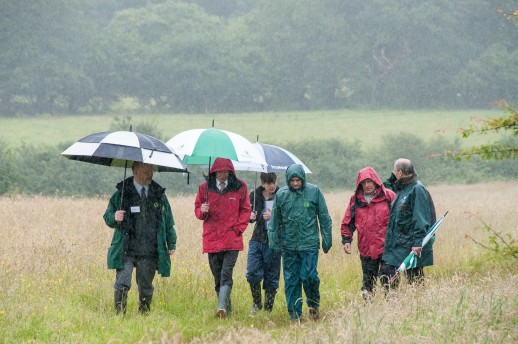
Clive Davis from the Forestry Commission has sent us an interesting article about ancient woodands in Wales.
Pictured at Cwm George and Casehill woodland during the launch of the Ancient Woodland Inventory are, left to right, Bill MacDonald (FC Wales), Environment Minister John Griffiths, his private secretary, Shona O’Shea, Trefor Owen (FC Wales), Morgan Parry (CCW), Jerry Langford (Woodland Trust).
A nationwide survey of Wales’s ancient woodlands has identified thousands of hectares of these “living monuments” that lay previously undiscovered.
Environment Minister John Griffiths launched the revised Ancient Woodland Inventory on Thursday, July 12, which showed that Wales now has 95,000 hectares of ancient woodland – an increase of more than 50% since the last record made eight years ago.
The huge leap in the amount of this precious and irreplaceable resource from the previous estimate of 62,000ha is due to the use of more accurate, digital maps and more precise methods which enabled new areas to be identified.
The Minister launched the inventory when he visited one of the new areas of ancient woodland that has been recognised at Cwm George and Casehill woodland, near Dinas Powys in the Vale of Glamorgan.
Mr Griffiths said ancient woodlands were one of Wales’s most valuable assets.
“They are not just museum pieces which need to be preserved, but can also be a valuable asset, providing wider benefits,” said the Minister.
“Managed sensitively and sustainably, ancient woodlands can yield timber and generate jobs which will contribute to the Welsh economy, as well as improving biodiversity, sequestering carbon and providing diverse habitats which add to our stunning landscapes.”
Ancient woodlands are areas that are believed to have been wooded for at least 400 years and may date as far back as the original Welsh “wildwood”. The increase in area means they represent over 30% of all woodlands in Wales.
Mr Griffiths said, “But, of course, these additional ancient woodlands have not just been created. They have simply been recognised for their value as a result of the new methods used.
“I was interested to hear that new technology has played a major part in the revision – so something old has been identified using something new.”
The revised inventory was commissioned by Forestry Commission Wales and the Countryside Council for Wales with support from Coed Cadw/Woodland Trust, which owns Cwm George and Casehill woodland.
Ancient woodlands are our richest and most important sites for a vast range of insects, birds, animals, flowers and trees and are home to more threatened species than any other UK habitat.
Mr Griffiths said, “Ancient woodlands are also a link with our past. They are living monuments which don’t just consist of trees, but also the associated flora and fauna which has taken centuries to establish.
“They may also have historical and archaeological significance and they can be a source of inspiration for local culture and folklore. We can imagine how, over the centuries, these woodlands will have played a role in the lives of generations.”
The new inventory will help to steer development away from ancient woodlands as the Welsh Government’s Planning Policy Wales, which gives guidance to local authorities, recognises the importance of these irreplaceable habitats.